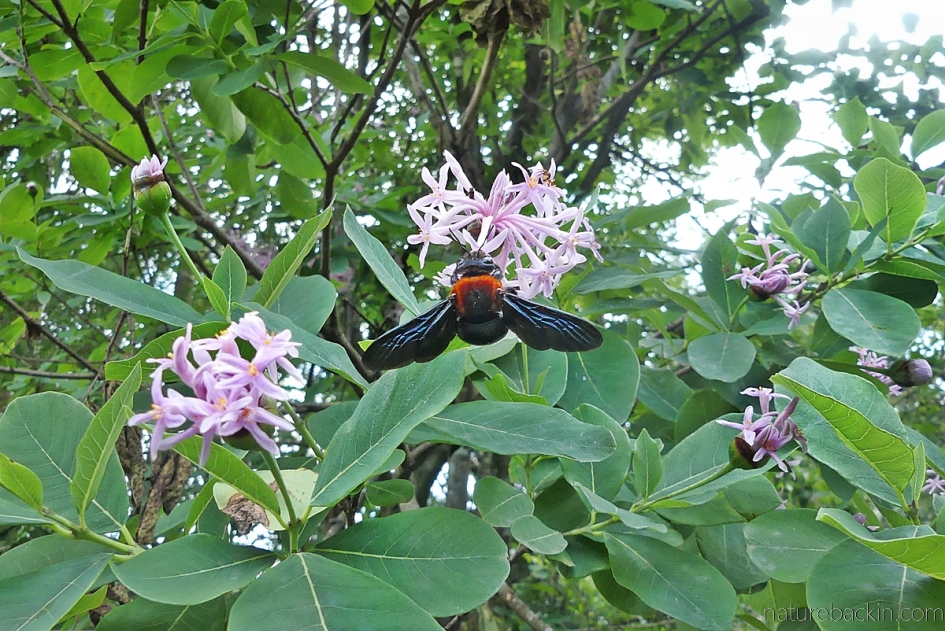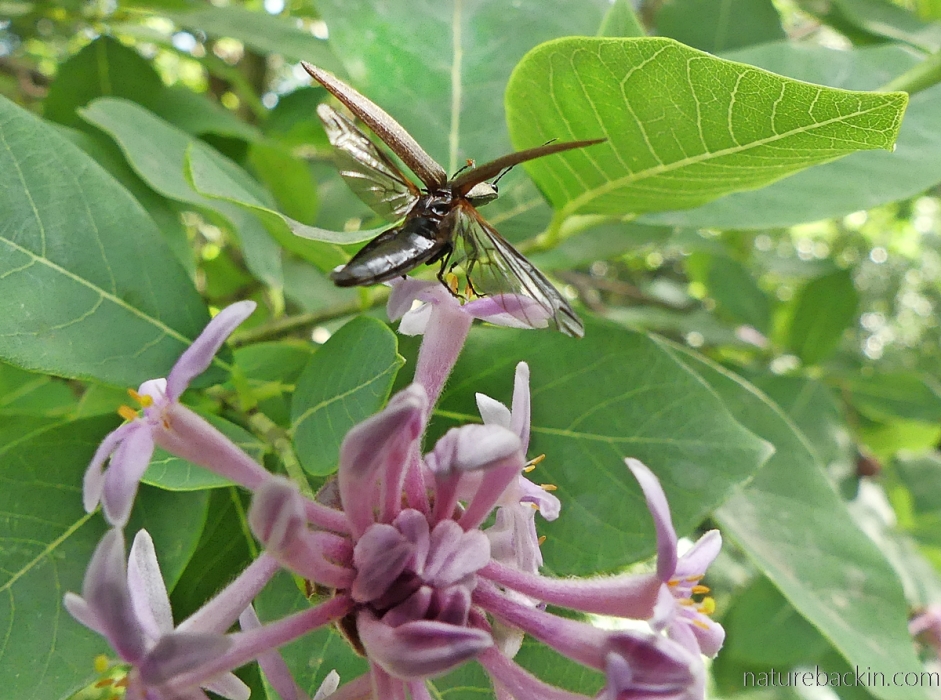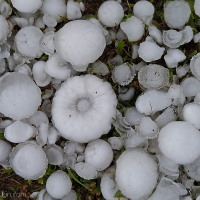Many flowers not only please the eye but brighten the mood – so this post features some mood brightening flowers. And there’s more! All of the featured flowers have attracted a visitor. Some of the visitors might be cheering and others less so, but they are all interesting. Guaranteed!
Insects and other creatures that visit flowers for their nectar and pollen, service the plants by transferring pollen from flower to flower and so are unwittingly fertilizing the flowers in the process. There are many pollinating insects, but honeybees attract a lot of the limelight.

A honeybee (Apis mellifera scutellata) visiting a cheerful yellow everlasting, Helichrysum cooperi
A celebrated benefit that we extract from honeybees (Apis mellifera scutellata) is of course in the form of honey, but the pollinating services of honeybees are widely recognised too. Despite the fact that they have the ability to sting in defence of their hive, honeybees are generally held in high regard by humans.

A honeybee, with its pollen sacs bulging, forages on a flower head of a paintbrush lily (also known as a snake lily), Scadoxus puniceus
There are plants that are adapted to flower even in environments that are subject to extreme conditions – so there are plants that thrive in deserts, mountains and marshes and everything in between. Here where we are in KwaZulu-Natal, South Africa, the winters are mild and the garden is planted with summer- and winter-flowering plants and those that flower in the cusp seasons of spring and autumn. For most of the year there are at least some flowers in the garden to provide food for birds, insects and other creatures.

Each spring, along with the honeybees and other pollinators, I look forward to the delicate pale blue flowers of the blue squill (formerly Scilla natalensis but now combined with two other species under the name Merwilla plumbea). But this year, for the first time to our knowledge, the blue squills failed to flower for some unknown reason. The above photo was taken a few springtimes ago
Since the ferocious hailstorm of a few weeks back, there have not been many flowers in the garden. Most of the garden plants were shredded and bruised by the hailstones, but it is interesting to see tiny shoots of new leaves emerging and growing stronger as the plants recover.
When thinking about this post I was even more aware of how few flowers there are left in the garden since the hailstorm. On the few remaining tatty Helichrysum plants still standing there are some yellow everlasting flowers – living up to their name. In the shelter of undergrowth that is now deeply mulched by hail-induced fallen leaves and tree debris, a few flowers of the black-eyed Susans (Thunbergia alata) have remained.
The exception – currently in magnificent flower – is the pompon tree (Dais cotinifolia). When the hailstorm struck, the tree’s flower buds were still tightly furled little balls that survived the onslaught of the large hailstones and subsequent heavy rain and gusting winds.

This week while photographing flowers on the pompon tree I was standing really still and so I was unnoticed by this giant carpenter bee (Xylocopa flavorufa) that arrived suddenly to feed on the flowers
Perhaps I will do a future post featuring this lovely flowering tree. This week I found several insects enjoying the pompon flowers and I discovered tiny spiders lurking in the petals, all too small for me to photograph. But I did manage to photograph two larger and very interesting visitors.

Not easy to photograph in the dimness of dusk and because of its slenderness, I spotted this elephant mosquito (Toxorhynchites brevipalpis)
By mosquito standards, the elephant mosquito is very large. It has a wingspan of 18mm compared to the wingspan of the bush mosquito (Aedes) 6–8mm wingspan and the 10mm wingspan of the malaria mosquito (Anopheles). But fear not – adult elephant mosquitoes of both sexes feed on nectar and do not feed on blood. And in more good news, their larvae predate on the larvae of other mosquitoes, particularly the larvae of the bush mosquito. Elephant mosquito larvae occur in water-filled cavities in tree trunks and in water that collects in the leaf axils of plants.

After feeding on pollen from several flowers, this beetle climbed up onto the petals of a flower before it spread its wings and flew away. I have not been able to identify this unusual insect – any assistance would be very welcome

This isn’t a very good photo, but it gives some idea of what the beetle looked like just before it flew away
Of course not all insects (or spiders) that visit flowers are there to feed on nectar or pollen – some visit to eat the pollinators! A good example is the flower assassin (Rhynocoris sementarius). The flower assassin waits in flowers and leaves to catch its prey, which includes honeybees and stink bugs. Like most assassin bugs, it uses its long ‘beak’ or rostrum to inject a salivary excretion that contains toxins as well as digestive enzymes that liquefy and pre-digest the internal body parts of the prey item, which the assassin bug then sucks up.

This flower assassin waits in ambush for pollinators on a wild iris (Dietes grandiflora) flower. Its long mouth part (rostrum) curves under its body. Assassin bugs use the rostrum for injecting prey and also for stridulating, that is to produce sound when the tip is rubbed on ridges under the body

Here is a very tiny crab spider in the family Thomisidae waiting in a nasturtium flower to catch a visiting pollinator. These little spiders have the ability to catch creatures that are quite a bit larger than themselves

Also on a flowering nasturtiums in the herb garden, I saw this skipper butterfly, possibly a common hottentot skipper (Gegenes niso)

Likewise visiting the nasturtium flowers was an ant most likely in search of aphids, and also visible is a very tiny unidentified insect

And here is a blue flower with a butterfly, one of the blues, perched at the base of the flower. The blue flower is the Natal blue bell (Thunbergia natalensis) and the butterfly? Well the blues can be notoriously difficult to identify. Possibly this is an African grass blue (Zyzeeria knysna knysna)
As I have mentioned before in a previous post, typically flies are not given their due as pollinators, but many adult flies feed on nectar. For some species of plant flies are the primary pollinators.

This fly (possibly one of the Tachninidae) with its long tongue visible, is enjoying feeding on a yellow everlasting flower

A hoverfly balances with its forelegs on a petal of a flower of the ribbon bush (Hypoestes aristata)

Although this is not the clearest photo of what I think is one of the needle-nose flies, I like how it looks so determined as it is lining up approaching a flower on a shell bush (Orthosihon labiatus)
After the challenging (at least for me) mathematics of last week’s post on fractals, I decided to take a break from the series of posts on patterns in nature, although I will be returning to this series at a later stage. And in case you are wondering, I have not forgotten about featuring spiral patterns.
So this week, when there is so much that is bleak around us across the globe be it winter or summer, I thought flowers and their visitors might bring us some much needed cheer.

Another needle-nose fly, possibly Philoliche athiopica, also attracted to a flower of a shell bush (Orthosihon labiatus), which is a member of the sage family
Sources: Picker, Mike, Griffiths, Charles & Weaving, Alan. 2019. Field Guide to Insects of South Africa. Cape Town: Struik Nature; Pooley, Elsa. 1998. A Field Guide to Wild Flowers of KwaZulu-Natal and the Eastern Region. Durban: Natal Flora Publications Trust; Woodhall, Steve. 2013. Butterflies of South Africa. Pocket Guide. Cape Town: Struik Nature.
Posted by Carol









December 12, 2020 at 11:14 am
Great post, Carol, as always. And yes, you are right! I am full of longing for colourful flowers with lots of insects buzzing around! Your flowers in the garden will be back for sure. Have a lovely weekend!
LikeLiked by 1 person
December 12, 2020 at 5:56 pm
Thanks very much Simone. I am sure you are already looking forward to springtime! We are having a very wet weekend with lots of rain – and we are not complaining as so much of the country is still very dry. Hope you are having a good break over the weekend.
LikeLiked by 1 person
December 12, 2020 at 4:52 am
Great photos and, yes, flowers and insects are a mood lifter. It doesn’t matter how I feel, seeing a butterfly on a flower always makes me forget whatever is bothering me. That Natal blue bell is quite lovely.
LikeLiked by 1 person
December 12, 2020 at 5:50 pm
Yes butterflies in particular are a tonic. The Natal blue bell is lovely – it thrives in shade. Ours all originated from one plant and they have self-seeded most successfully. I really enjoy them and their soft shade of blue.
LikeLiked by 1 person
December 11, 2020 at 8:15 am
Yet another astounding post. Thank you for once again delighting and educating me, Carol.
LikeLiked by 1 person
December 12, 2020 at 5:47 pm
Thanks so much Mariss!
LikeLiked by 1 person
December 11, 2020 at 6:15 am
Yes indeed, this is a cheering post, and your cheering sights have little in common with ours in the UK. The honeybee maybe? The nasturtium? The everlasting flower? It’s quite exciting to meet your very different neighbours!
LikeLiked by 1 person
December 12, 2020 at 5:46 pm
Thank you Margaret. I think we all need to find all the cheer we can get!
LikeLiked by 1 person
December 11, 2020 at 4:50 am
Your photographs are exquisite! Our pompon trees are filled with swelling buds, so I am hoping we will have a wonderful show of flowers soon; the Cape Chestnut is also blooming. This has been an interesting post and I have learned a great deal from it.
LikeLiked by 1 person
December 12, 2020 at 5:39 pm
Thank you Anne. Your pompon trees seem to be a bit behind ours – I hope they have abundant flowers. Our Cape Chestnut is over by now, but it was a good flowering season this year.
LikeLike
December 11, 2020 at 3:32 am
Definitely a sight for sore eyes Carol, lovely! Often when I take photographs of flowers I ‘discover’ the myriad of small creatures when I take a good look at them, such a magical world within! xxx
LikeLiked by 1 person
December 12, 2020 at 5:37 pm
So true what you say – worlds within worlds!
LikeLiked by 1 person
December 11, 2020 at 1:57 am
Most definitely a feast for the eyes and a mood-lifter of note – thank you, Carol!
LikeLiked by 1 person
December 12, 2020 at 5:36 pm
Thanks 🙂
LikeLike
December 11, 2020 at 12:34 am
Excellent photos, Carol. I appreciate seeing the cheerful flowers, and the insects, too. I miss mine!
LikeLiked by 1 person
December 12, 2020 at 5:36 pm
Thanks Eliza. I sure you miss them. I still find it hard to imagine the long cold winters that you have in your part of the world. Hope you keep warm and cosy but that the weather provides gaps for the occasional outing.
LikeLike
December 12, 2020 at 5:56 pm
Unless it is below -14C, I dress warmly and go out for a long walk everyday. I’d go crazy (crazier?) if I stayed inside all winter. CC has made our winters milder, which makes being outside more comfortable, but I tend to worry about our plant life which is adapted to long, cold winters.
LikeLiked by 1 person
December 12, 2020 at 6:00 pm
I have never experienced anything like that – the coldest I have experienced was a short time in a snowy Luxembourg many years ago. I learnt then why one needs to wear a warm hat! I was astonished how much heat one seems to lose through one’s head!
The milder winters are a concern when they are so abnormal, Anyway, I am glad that you can get out – but it sounds very brave to me!
LikeLike
December 12, 2020 at 6:46 pm
No choice, ha! It is easier for me as I’ve always lived in this climate, so I’ve adapted to the seasons and can find beauty even in winter. However, the cold is no friend of the aging body. 😉
LikeLiked by 1 person
December 10, 2020 at 10:52 pm
Yes, flowers definitely can bring beauty to the souls (hearts). It performs wonder.
LikeLiked by 1 person
December 12, 2020 at 5:33 pm
Indeed they do. Thank you.
LikeLike